Recently updated on December 12th, 2024 at 05:25 am
The bathroom, often regarded as a sanctuary of privacy and personal care, paradoxically becomes a potential hotspot for accidents and hazards as individuals age. Aging is accompanied by a multitude of bodily changes that render seniors more vulnerable to mishaps and injuries, and nowhere is this vulnerability more evident than in the bathroom.
The typically wet and slippery surfaces in this space can quickly transform mundane activities like bathing into perilous endeavors.

In this guide, we embark on a journey to unveil not just mere safety precautions but 11 indispensable bathroom safety for elderly, precisely curated. Our primary goal is to safeguard their well-being and nurture their independence.
By delving into these expertly crafted recommendations, you’ll gain valuable insights and practical solutions to transform the bathroom so that seniors can confidently navigate their daily routines without compromising their safety or dignity.
Why Bathroom Safety for Seniors is Crucial
Bathroom safety for seniors is not just a matter of convenience; it’s a critical aspect of their overall well-being. Here’s why it’s crucial:
- Increased Risk of Falls: Seniors are more prone to falls due to changes in balance, muscle strength, and mobility. The bathroom, with its slippery floors, is a high-risk area.
- Fractures and Injuries: Falls in the bathroom can lead to severe injuries, including fractures, sprains, and head trauma. Recovery from such injuries can be challenging for seniors.
- Maintaining Independence: Most seniors value their independence and wish to age in place. Bathroom safety measures can help them continue to use the bathroom independently.
Bathroom Safety Tips For Elderly:
1. Non-Slip Flooring and Mats
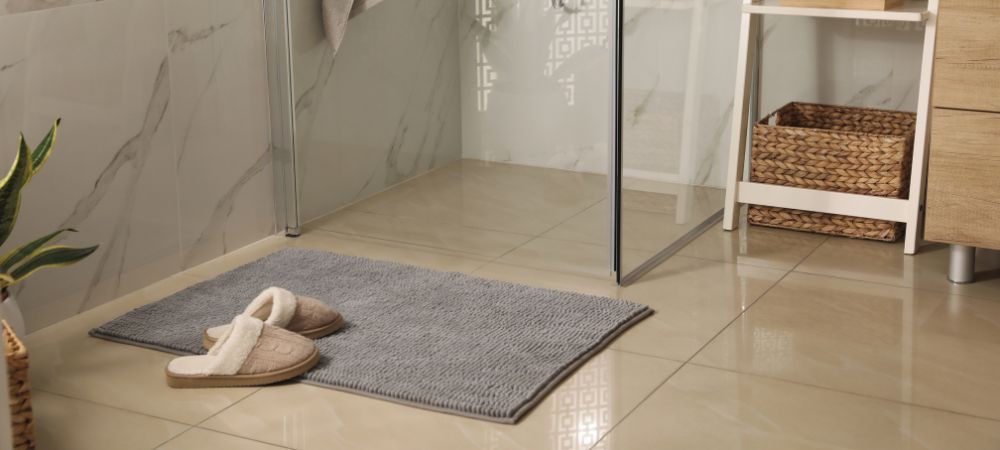
One of the most effective bathroom safety tips for seniors is to address the issue of slippery surfaces. Bathroom floor safety for elderly is mandatory. Here’s how to make bathroom floors safer:
- Non-Slip Mats: Invest in non-slip mats with rubber or textured surfaces. These mats provide stability and prevent slipping when stepping out of the shower or tub. They are must-haves to prepare a safe bathroom for elderly.
- Textured Tiles: Opt for textured or non-slip tiles for the bathroom floor. These tiles have a rougher surface, offering better traction even when wet.
- Coatings and Sealants: Consider applying non-slip coatings or sealants to existing tiles. These products create a slip-resistant surface without changing the appearance of the tiles.
- Regular Cleaning: Ensure mats and flooring are regularly cleaned to remove any soap scum or residue, which can reduce their non-slip properties.
2. Grab Bars Installation
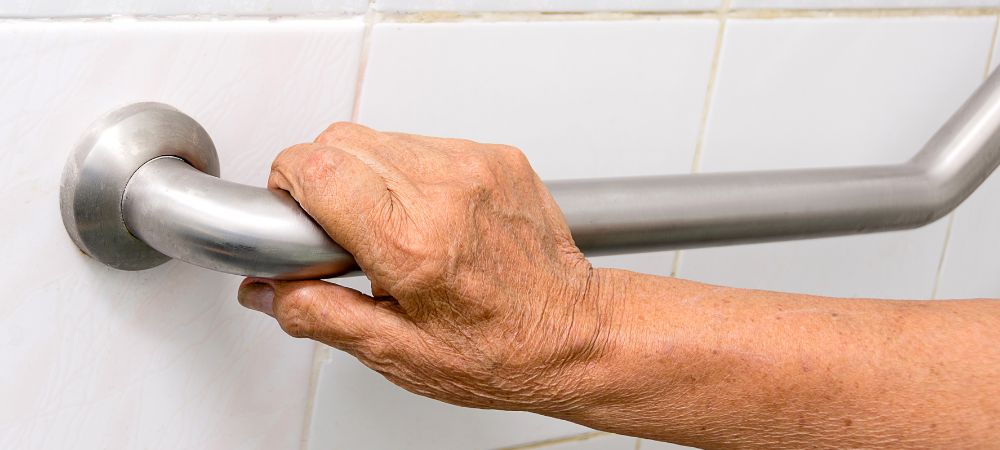
Grab bars are essential safety features that provide stability and safety in the bathroom for elderly. Here’s how to install them effectively:
- Strategic Placement: Determine the optimal locations for grab bars, which typically include near the toilet, inside the shower or tub, and near the sink. These areas are where seniors often need support.
- Proper Height: Install grab bars at a height that allows seniors to easily reach and grip them without excessive bending or stretching.
- Secure Installation: Ensure that grab bars are securely fastened to the wall using appropriate anchors and mounting hardware. They should be able to support the user’s full weight without coming loose.
- Non-Slip Material: Look for grab bars made from non-slip materials, which provide a better grip even when wet. Textured or ribbed bars are excellent choices.
With them you can rest assured that the elderly getting up at night to use bathroom safely is possible.
3. Raised Toilet Seats

Raised toilet seats are valuable aids in making an accessible bathroom for seniors. They are one of the key bathroom safety features for elderly. Here’s what you need to know about them:
- Height Adjustment: Choose a raised toilet seat with adjustable height settings. This allows customization to meet the user’s specific needs and comfort level.
- Easy Installation: Most raised toilet seats are designed for straightforward installation. They typically attach securely to the existing toilet bowl without the need for special tools.
- Locking Mechanism: Ensure that the raised toilet seat has a reliable locking mechanism to prevent it from shifting or coming loose during use.
- Cleaning and Maintenance: Opt for raised toilet seats made of easy-to-clean materials. Regular cleaning is essential to maintain hygiene.
4. Shower Chairs and Benches
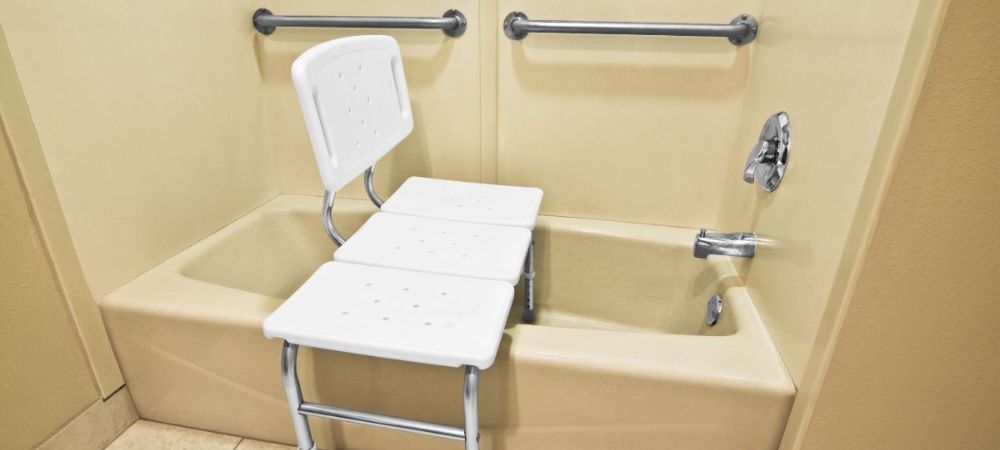
Shower chairs and benches provide a stable and comfortable place for seniors to sit while bathing. Here are some key considerations:
- Material and Design: Choose a chair or bench made from waterproof and corrosion-resistant materials such as plastic or aluminum. These materials withstand the humid bathroom environment.
- Backrest and Armrests: Some shower chairs come with backrests and armrests, which offer additional support and comfort, particularly for seniors who may have limited mobility.
- Adjustability: Look for chairs or benches with adjustable legs to accommodate various heights and ensure a secure fit within the shower or tub.
- Non-Slip Feet: Ensure that the chair or bench has non-slip rubber feet to prevent it from moving or sliding during use.
5. Walk-In Tubs and Roll-In Showers

Traditional bathtubs can pose significant challenges for seniors due to their high sides and the need to step over them. Walk-in tubs and roll-in showers offer more accessible bathing solutions and ensure safety at bathroom:
- Accessibility: Walk-in tubs have low entry thresholds, allowing seniors to enter and exit with minimal effort. Roll-in showers feature barrier-free entry, making them wheelchair-friendly.
- Safety Features: Many walk-in tubs and roll-in showers come equipped with safety features like built-in grab bars, non-slip flooring, and anti-scald technology to prevent burns from hot water.
- Hydrotherapy Options: Some walk-in tubs offer therapeutic features such as hydrotherapy jets, which can provide relief for seniors with arthritis or muscle pain.
- Professional Installation: Ensure that these modifications are professionally installed to guarantee their safety and functionality.
6. Adequate Lighting
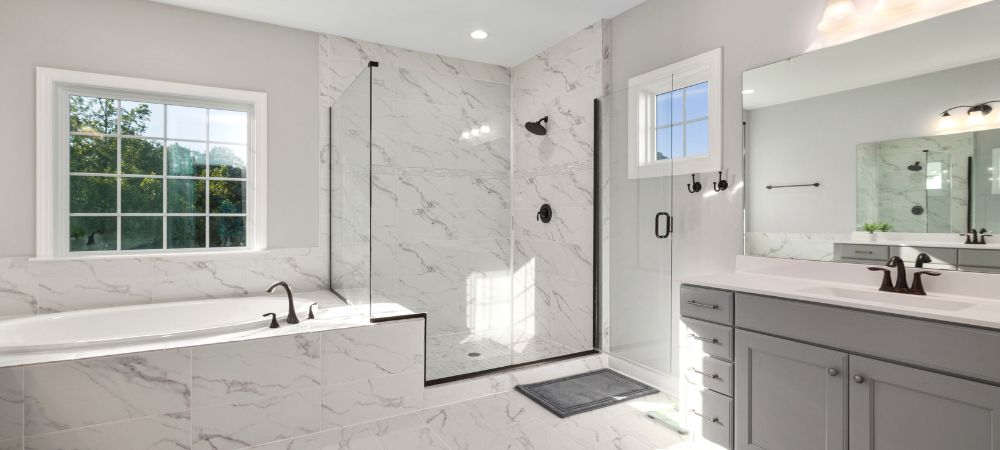
Proper lighting is crucial in preventing accidents in the bathroom. Here’s how to ensure your bathroom is well-lit:
- Bright Bulbs: Choose bright, energy-efficient bulbs that provide ample illumination. LED lights are an excellent choice for their brightness and energy efficiency.
- Layered Lighting: Implement layered lighting with multiple light sources, including overhead fixtures, wall sconces, and task lighting. This allows for flexibility in adjusting the level of brightness.
- Motion-Activated Lights: Install motion-activated lights, especially in areas like the hallway leading to the bathroom. These lights automatically turn on when someone enters the space, eliminating the need for fumbling with switches in the dark. They can also enhance elderly bathroom safety and aid fall prevention.
- Nightlights: Consider using nightlights in the bathroom and along the pathway leading to it. Nightlights provide a soft, continuous glow that helps seniors navigate safely at night without fully waking them.
7. Medication Management
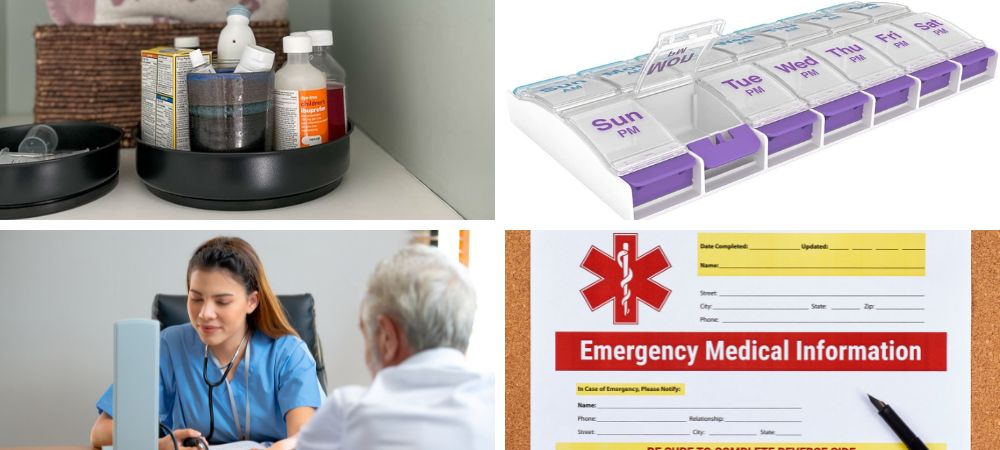
Effective medication management for seniors is crucial to stay healthy and prevent accidents related to medication use:
- Storage: Store medications in a dry, cool place outside the bathroom to prevent moisture damage. Bathrooms tend to be humid, which can affect the potency of some medications.
- Medication Organizers: Use medication organizers or pill dispensers to keep track of daily doses. These organizers are typically labeled with the days of the week and times of day, making it easy for seniors to remember when to take their medications.
- Regular Check-Ins: Regularly check that seniors are taking their medications as prescribed. You can set up a system of reminders or enlist the help of a caregiver or family member if needed.
- Emergency Information: Keep a list of emergency contacts and medical information near the bathroom, in case of accidental ingestion or overdose. This can be invaluable in urgent situations.
8. Personal Emergency Response Systems

Investing in a personal emergency response system (PERS) can provide peace of mind for both seniors and their loved ones:
- Wearable Devices: PERS often come in the form of wearable devices or pendants with a button that can be easily activated in case of an emergency. These devices are typically waterproof, ensuring they can be worn in the bathroom.
- 24/7 Monitoring: Choose a PERS service with 24/7 monitoring. When the emergency button is pressed, a trained operator can quickly assess the situation and dispatch help if necessary.
- Fall Detection: Some PERS devices offer fall detection technology, which can automatically trigger an alert if it detects a fall, even if the user is unable to press the button.
- Regular Testing: Test the PERS device regularly to ensure it’s in working order, and the batteries are charged. This ensures it will function when needed.
9. Handheld Showerheads
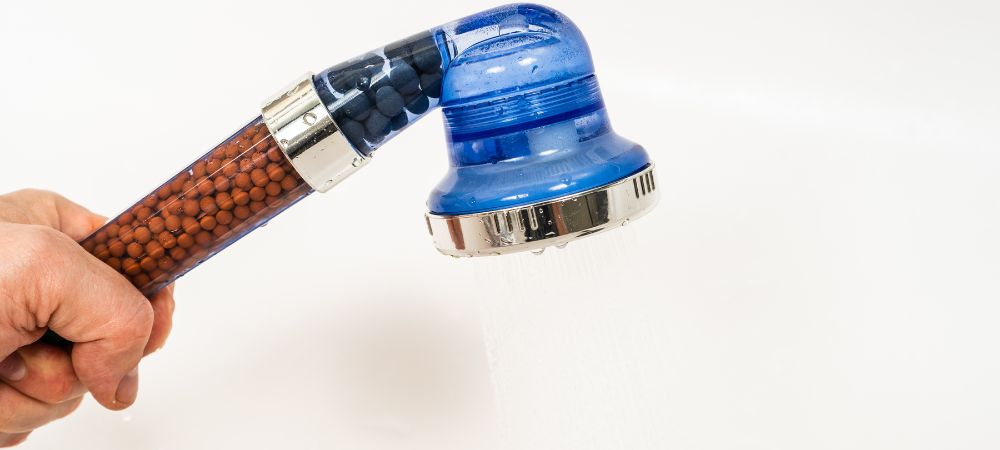
Handheld showerheads offer seniors with limited mobility greater flexibility and convenience in their daily bathing routines. Here are some essential considerations for this bathroom safety for seniors modification:
- Adjustable Height: Opt for a handheld showerhead with an adjustable height feature. This allows seniors to customize the showerhead’s position, ensuring it is within comfortable reach. Adjusting the height can accommodate individuals of varying heights and mobility levels.
- Long Hose: Ensure that the handheld showerhead comes equipped with a long hose. A lengthy hose enables seniors to shower while seated on a shower chair or bench, providing them with a safe and comfortable bathing experience. It eliminates the need to stretch or maneuver unnecessarily, reducing the risk of falls.
- Easy Grip: Choose a handheld showerhead with an ergonomic handle designed for ease of grip, even with wet hands. This feature ensures that seniors can confidently control the water flow and direction during their showers, enhancing both safety and comfort.
10. Why Decluttering Matters:
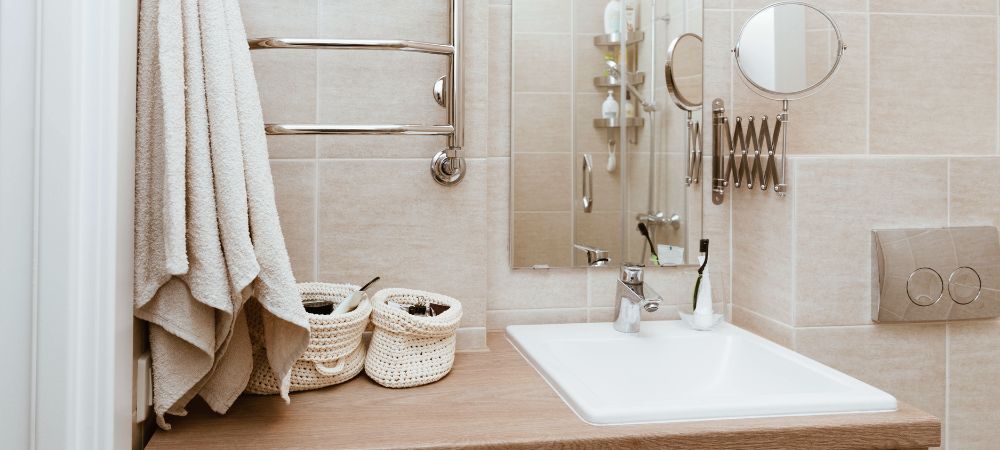
Decluttering the bathroom is a crucial step in enhancing safety for elderly individuals. The presence of numerous toiletries and clutter in this space can lead to accidents, especially for seniors who may have limited mobility. Here’s why decluttering is essential and some practical tips to achieve a safer and more organized bathroom:
- Reduced Risk of Falls: Clutter on shower floors or countertops increases the likelihood of items getting knocked over, leading to potentially hazardous bending or reaching for seniors.
- Improved Accessibility: Seniors with mobility challenges may struggle to access items stored in high or hard-to-reach places. Decluttering ensures that essential items are within easy reach.
- Enhanced Maneuverability: A clutter-free bathroom offers more space for seniors to move around safely. This is particularly important in tight bathroom quarters.
- Practical Tips for Decluttering: Organize with Shower Caddies: Use shower caddies to neatly organize shampoos, conditioners, shower gels, and soaps. These caddies can be hung at body level, making it easy for seniors to access their daily essentials.
- Lower Shelving: Create lower shelving or storage areas for combs, brushes, and other daily grooming items. Lower shelves are more accessible and reduce the need for seniors to bend over or stretch.
- Plastic Drawers: Consider using plastic drawers in the bathroom. These drawers are easier to reach than high cupboards and can be used to store various items, keeping them organized and accessible.
- Regular Maintenance: Establish a routine for checking the bathroom floor and countertops for clutter. Ensure that clothing, unused items, and decor are promptly removed to maintain a clear and safe space.
- Storage Solutions: Invest in bathroom storage solutions like wall-mounted cabinets or open shelving units. These can help keep essential items organized and off the counters.
- Unused Items: Identify items that are not used regularly and store them away in a designated cabinet or closet. Clear countertops and surfaces of any items not in daily use.
- Bathroom Decor: Assess bathroom decor items for potential hazards. Anything that could be a tripping hazard or obstructing movement should be removed or rearranged.
11. Regular Maintenance

Regular maintenance of bathroom safety features is vital to ensure their continued effectiveness in preventing accidents. Here are key points for maintaining a safe bathroom environment:
- Inspect Grab Bars: Periodically inspect the grab bars for any signs of loosening, rust, or wear. If you notice any issues, promptly tighten or replace them. Securely installed grab bars are crucial for stability and support.
- Test Non-Slip Surfaces: Regularly test the non-slip mats and flooring to ensure they maintain their slip-resistant properties. Over time, these surfaces may wear down, reducing their effectiveness. Replace them if you observe signs of deterioration to maintain a secure footing.
- Replace Outdated Equipment: If any safety equipment or modifications become outdated or damaged, replace them without delay. Up-to-date safety features are essential for providing a secure environment for seniors.
- Cleaning Routine: Establish a regular cleaning routine for the bathroom to prevent the buildup of soap scum and mold. These can create slippery surfaces that pose a significant hazard. Regular cleaning not only ensures hygiene but also enhances overall safety.
FAQs
The Bottom Line:
Bathroom safety for seniors is paramount, as it directly contributes to their independence and overall well-being. These 11 bathroom safety tips, when diligently applied, transform the bathroom into a haven of security and comfort for elderly loved ones.
By proactively addressing potential hazards and making necessary modifications, we not only reduce the risk of accidents but also empower seniors to maintain their autonomy. Prevention takes precedence, and through these measures, we safeguard our seniors, ensuring that their daily routines remain manageable, dignified, and injury-free.
Why Choose Loving Homecare Inc. for Bathing Assistance For Elderly?
- Expertise and Compassion: Our team comprises dedicated professionals with expertise in elderly care, coupled with a deep sense of compassion for seniors’ well-being.
- Customized Care: Loving Homecare Inc. provides personalized bathing assistance, recognizing that each senior has unique needs and preferences.
- Safety as a Priority: We prioritize safety above all else, ensuring that seniors can bathe securely without the risk of accidents or injuries.
- Dignity and Comfort: Our caregivers are trained to uphold seniors’ dignity and provide a comfortable and respectful bathing experience. Apt assistance for elderly in bath is guaranteed.
- In-Home Convenience: Seniors can enjoy the comfort and familiarity of their own homes while receiving bathing assistance from our experienced team.
- Bathroom Safety Enhancements: We incorporate essential safety features and make necessary adjustments to create a senior-friendly bathroom environment.
- Mobility Aid Support: Our caregivers are well-versed in assisting seniors with mobility aids, ensuring a seamless bathing experience.
- Peace of Mind: Choosing Loving Homecare Inc. means choosing peace of mind, knowing that your loved ones are receiving the highest level of personal care during their bathing routines.

